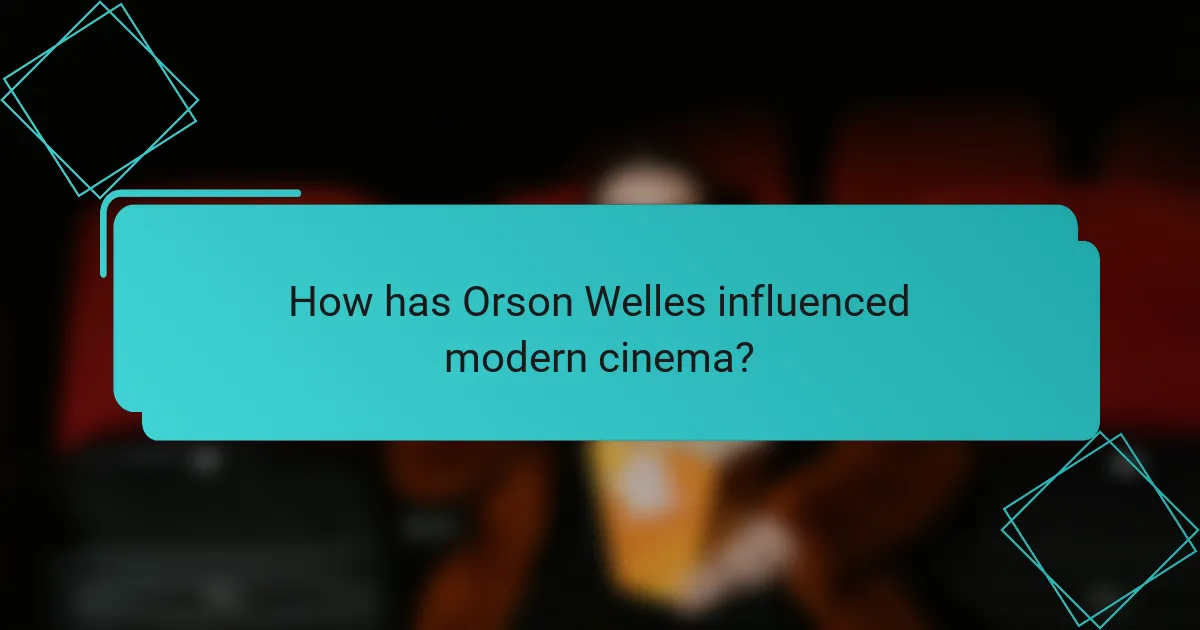Orson Welles is a pivotal figure in cinema, recognized for his groundbreaking techniques and influential works. His debut film, “Citizen Kane,” is celebrated for its innovative narrative structure, deep focus cinematography, and distinctive use of lighting and sound. Welles’ contributions extend beyond film, impacting radio and theater, with notable productions such as “The Magnificent Ambersons” and “Touch of Evil.” His approach to storytelling and technical advancements has inspired generations of filmmakers, solidifying his legacy as a transformative force in the history of cinema. This article explores Welles’ revolutionary techniques, significant works, and lasting influence on modern filmmaking.

What makes Orson Welles a revolutionary figure in cinema?
Orson Welles is a revolutionary figure in cinema due to his innovative storytelling and technical advancements. He transformed narrative structure with non-linear timelines and complex characters. His debut film, “Citizen Kane,” is often hailed as the greatest film of all time. Welles utilized deep focus cinematography, allowing multiple planes of action in a single shot. This technique added depth and realism to storytelling. He also pioneered the use of lighting and shadow to enhance mood and atmosphere. Welles’ bold experimentation with sound design changed how audio was integrated into film. His work challenged traditional Hollywood norms and inspired future filmmakers to push boundaries. These contributions solidified Welles’ legacy as a transformative force in cinematic history.
How did Orson Welles’ early life influence his filmmaking style?
Orson Welles’ early life significantly influenced his filmmaking style. His childhood was marked by artistic exposure and a sense of independence. Welles was a child prodigy, performing in theater by age 16. He was heavily influenced by his mother, who was a concert singer, and his father, a successful inventor. This artistic environment fostered his creativity and ambition. Welles’ experiences in Europe, particularly in theater, shaped his narrative techniques and visual style. His early work in radio, including the famous “War of the Worlds” broadcast, showcased his innovative use of sound. These formative experiences contributed to his distinctive approach to storytelling and cinematic techniques in films like “Citizen Kane.”
What experiences shaped his artistic vision?
Orson Welles’ artistic vision was shaped by his early experiences in theater and radio. His work with the Federal Theatre Project exposed him to innovative storytelling techniques. Collaborating with influential figures like John Houseman enhanced his creative approach. Welles’ groundbreaking radio adaptation of “War of the Worlds” demonstrated his ability to manipulate audience perception. His childhood in Wisconsin, surrounded by artistic influences, further cultivated his imagination. Traveling to Europe also expanded his understanding of different artistic movements. These formative experiences collectively informed his unique style in film and theater.
How did his background in theater contribute to his film techniques?
Orson Welles’ background in theater significantly influenced his film techniques. His experience in stage direction enhanced his understanding of performance and blocking. Welles emphasized the importance of actors’ physical placement in scenes. This approach created dynamic visual storytelling in his films. Additionally, his theatrical training fostered innovative use of lighting and shadow. He applied these techniques to evoke emotions and mood. Welles also utilized deep focus cinematography, a method that reflects stage composition. This method allowed viewers to engage with multiple layers of action. Overall, Welles’ theatrical roots were foundational in shaping his cinematic artistry.
What are the key techniques that Orson Welles pioneered?
Orson Welles pioneered several key techniques in filmmaking and theater. He is known for his innovative use of deep focus cinematography. This technique allows foreground and background elements to remain in sharp focus simultaneously. Welles also popularized non-linear storytelling. His film “Citizen Kane” employs flashbacks and multiple perspectives to narrate the story. Additionally, he utilized innovative sound design in film. The radio play “War of the Worlds” showcased his ability to create immersive audio experiences. Welles’ incorporation of theatrical techniques in film, such as stage lighting and set design, set new standards in cinematic storytelling. His work has influenced generations of filmmakers and remains a cornerstone of modern cinema.
How did he utilize innovative narrative structures in his films?
Orson Welles utilized innovative narrative structures in his films by employing non-linear storytelling and multiple perspectives. He often fragmented timelines to create suspense and engage viewers. A prime example is “Citizen Kane,” where the narrative unfolds through flashbacks from various characters. This technique allows audiences to piece together the protagonist’s life from differing viewpoints. Welles also incorporated innovative editing and deep focus cinematography. These methods enhanced character depth and thematic complexity. His approach challenged traditional narrative forms, influencing future filmmakers.
What role did sound design play in Welles’ filmmaking approach?
Sound design played a crucial role in Orson Welles’ filmmaking approach. Welles utilized sound to enhance storytelling and create atmosphere. He often employed innovative techniques, such as overlapping dialogue and ambient sounds. This approach added depth to character interactions and emotional resonance. For instance, in “Citizen Kane,” sound was used to signify transitions and shifts in time. Welles believed sound could evoke feelings, much like visuals. His collaboration with sound designer Bernard Herrmann further pushed creative boundaries. This emphasis on sound design influenced future filmmakers and changed cinematic language.
Why is ‘Citizen Kane’ considered a landmark film?
‘Citizen Kane’ is considered a landmark film due to its innovative narrative structure and technical achievements. The film employs non-linear storytelling, which was groundbreaking for its time. It utilizes deep focus cinematography, allowing for multiple planes of action to be in focus simultaneously. This technique was pioneered by cinematographer Gregg Toland. ‘Citizen Kane’ also features innovative sound design and editing techniques. The film’s exploration of complex themes, such as power and loss, adds to its significance. It received nine Academy Award nominations and won one for Best Original Screenplay. Critics and filmmakers often cite it as one of the greatest films ever made.
What unique storytelling elements were introduced in ‘Citizen Kane’?
‘Citizen Kane’ introduced unique storytelling elements such as non-linear narrative and deep focus cinematography. The film employs a fragmented structure, presenting events out of chronological order. This technique allows viewers to piece together the protagonist’s life from various perspectives. Additionally, deep focus cinematography keeps both foreground and background in sharp focus. This visual style enhances storytelling by allowing multiple actions to unfold simultaneously within a single frame. The use of innovative lighting and shadow also adds emotional depth to scenes. These elements collectively contributed to a groundbreaking approach in cinematic storytelling.
How did cinematography in ‘Citizen Kane’ redefine visual storytelling?
Cinematography in ‘Citizen Kane’ redefined visual storytelling through innovative techniques. Orson Welles and cinematographer Gregg Toland employed deep focus to keep multiple planes in sharp focus. This allowed for complex compositions and layered storytelling within a single frame. The use of low-angle shots created a sense of power and dominance for characters. Unique lighting techniques, such as chiaroscuro, enhanced emotional depth and mood. The film’s non-linear narrative structure was complemented by its visual style. These elements combined to create a more immersive and engaging viewing experience. ‘Citizen Kane’ set new standards for visual narrative that influenced future filmmakers.

What notable works did Orson Welles create throughout his career?
Orson Welles created several notable works throughout his career. His most famous film is “Citizen Kane,” released in 1941. This film is often regarded as one of the greatest movies of all time. Welles also directed and starred in “The Magnificent Ambersons,” which debuted in 1942. Another significant work is “Touch of Evil,” released in 1958, known for its innovative cinematography. Welles was also acclaimed for his radio work, particularly “The War of the Worlds,” which aired in 1938. His theatrical productions, including “Macbeth” and “Othello,” showcased his talent on stage. Each of these works contributed to his reputation as a groundbreaking artist in film, radio, and theater.
What are some of Welles’ most acclaimed films?
Orson Welles’ most acclaimed films include “Citizen Kane,” “The Magnificent Ambersons,” and “Touch of Evil.” “Citizen Kane,” released in 1941, is widely regarded as one of the greatest films of all time. It received nine Academy Award nominations and won an Oscar for Best Original Screenplay. “The Magnificent Ambersons,” released in 1942, is another critically acclaimed work, though it faced significant studio interference. “Touch of Evil,” released in 1958, is celebrated for its innovative cinematography and complex narrative structure. Each of these films has had a lasting impact on cinema and continues to be studied for their artistic achievements.
What themes are prevalent in Welles’ body of work?
Orson Welles’ body of work frequently explores themes of power, identity, and the human condition. His films often depict the corrupting influence of power, as seen in “Citizen Kane,” which critiques wealth and ambition. Welles also delves into the complexity of identity, particularly in “The Trial,” where characters grapple with existential dilemmas. Additionally, themes of betrayal and isolation are prevalent, reflecting the darker aspects of human relationships. The use of innovative narrative structures further emphasizes these themes, making his work both groundbreaking and thought-provoking.
How did ‘The Magnificent Ambersons’ challenge conventional filmmaking?
‘The Magnificent Ambersons’ challenged conventional filmmaking through its innovative narrative structure and visual techniques. The film employed a non-linear storyline, which deviated from traditional chronological storytelling. It utilized deep focus cinematography, allowing multiple planes of action to be in focus simultaneously. This technique enhanced the film’s emotional depth and complexity. Orson Welles also incorporated long takes, which created a sense of realism and immersion. The use of innovative lighting and set design further distinguished it from contemporary films. Additionally, the film’s critical view of wealth and social change contrasted with the typical romanticized narratives of the time. These elements collectively marked a significant departure from the filmmaking norms of the early 1940s.
What contributions did Welles make to radio and theater?
Orson Welles revolutionized radio and theater with innovative techniques. In radio, he is best known for “The War of the Worlds” broadcast in 1938. This program utilized realistic sound effects and dramatic storytelling. It caused widespread panic among listeners who believed it was an actual news report. Welles also pioneered the concept of the radio play as a serious art form. His work in theater included the groundbreaking production of “Macbeth” in 1936. This adaptation featured an all-Black cast and a unique setting. Welles’ contributions transformed both mediums and influenced future generations of artists.
How did his radio broadcasts impact public perception of media?
Orson Welles’ radio broadcasts significantly altered public perception of media. His 1938 “War of the Worlds” broadcast created widespread panic, demonstrating the power of radio as a medium. The realistic presentation led listeners to believe an actual alien invasion was occurring. This event highlighted the influence of media on public emotions and reactions. It prompted discussions about media responsibility and the potential for misinformation. Consequently, audiences became more critical of media sources. Welles’ innovative techniques also showcased radio’s storytelling capabilities, reshaping expectations of broadcast content. His work ultimately established radio as a legitimate art form, influencing future media practices.
What theatrical productions showcased Welles’ innovative techniques?
The theatrical productions that showcased Orson Welles’ innovative techniques include “Voodoo Macbeth,” “The Cradle Will Rock,” and “Othello.” “Voodoo Macbeth” was notable for its use of an all-Black cast and a unique setting that reimagined the classic play. “The Cradle Will Rock” featured a groundbreaking approach to audience engagement and live performance. “Othello,” directed by Welles, employed innovative staging and dramatic lighting to enhance the storytelling. These productions exemplified Welles’ ability to blend traditional theater with modern techniques, leaving a lasting impact on the theatrical landscape.

How has Orson Welles influenced modern cinema?
Orson Welles has significantly influenced modern cinema through innovative storytelling and technical advancements. His film “Citizen Kane” is often cited as a landmark in cinematic history. It introduced non-linear narratives and deep focus cinematography. Welles’ use of lighting and shadow created a distinct visual style. His techniques have inspired countless filmmakers, including Martin Scorsese and Francis Ford Coppola. Welles also challenged traditional narrative structures, paving the way for more experimental films. His work has become a foundation for modern filmmaking, emphasizing artistic expression and originality.
What lasting impact did Welles have on future filmmakers?
Orson Welles had a profound impact on future filmmakers through his innovative storytelling and technical prowess. His film “Citizen Kane” is often cited as a benchmark for cinematic excellence. Welles introduced techniques such as deep focus cinematography and non-linear narrative structures. These methods influenced generations of directors, encouraging creative experimentation. His emphasis on the director’s vision reshaped the role of filmmakers in Hollywood. Welles’ ability to blend theatricality with film opened new avenues for storytelling. His work inspired filmmakers like Martin Scorsese and Francis Ford Coppola. The legacy of Welles continues to be evident in contemporary cinema.
How do contemporary directors cite Welles as an influence?
Contemporary directors cite Orson Welles as an influence through his innovative storytelling and technical prowess. Directors like Martin Scorsese and Francis Ford Coppola reference Welles’ pioneering use of deep focus and non-linear narrative structures. Welles’ film “Citizen Kane” is often highlighted for its groundbreaking cinematography and editing techniques. His ability to blend theatricality with cinematic language has inspired many filmmakers. Additionally, Welles’ exploration of complex characters and themes resonates with modern storytelling. His impact is evident in the works of directors who prioritize artistic vision over commercial success. This legacy of creativity continues to shape the film industry today.
What elements of Welles’ style can be seen in modern films?
Orson Welles’ style is evident in modern films through innovative narrative techniques and visual storytelling. His use of deep focus cinematography allows multiple planes of action to be in focus simultaneously. This technique enhances the storytelling by immersing viewers in the scene’s environment. Welles’ non-linear storytelling also influences modern filmmakers. This approach creates suspense and engages the audience by revealing information out of chronological order. Additionally, his bold use of lighting and shadows contributes to the mood and atmosphere in contemporary cinema. This chiaroscuro effect can be seen in films that seek to evoke tension or drama. Welles’ emphasis on character-driven narratives remains a hallmark of modern filmmaking. His ability to blend theatrical elements with cinematic techniques continues to inspire directors today.
What lessons can filmmakers learn from Orson Welles’ career?
Filmmakers can learn the importance of innovation and creative storytelling from Orson Welles’ career. Welles revolutionized filmmaking with his techniques in “Citizen Kane.” He utilized deep focus, nonlinear narratives, and innovative cinematography. These elements transformed how stories could be told on screen. Filmmakers should embrace bold ideas and push boundaries. Welles faced significant challenges with studios, highlighting the need for perseverance. His ability to adapt to different mediums, like radio and theater, shows versatility is essential. Lastly, Welles’ commitment to artistic vision over commercial success is a powerful lesson in integrity.
How can aspiring directors apply Welles’ techniques in their work?
Aspiring directors can apply Welles’ techniques by focusing on innovative storytelling and visual composition. They should study his use of deep focus cinematography, which allows multiple planes of action to occur simultaneously. This technique enhances narrative depth and viewer engagement. Additionally, directors can adopt Welles’ approach to sound design, utilizing overlapping dialogue to create a more immersive experience.
Welles also emphasized the importance of character-driven narratives. Aspiring directors should prioritize character development to drive the plot. They can learn from Welles’ theatrical background, incorporating stage techniques to enhance performances.
Furthermore, Welles’ non-linear storytelling can inspire directors to experiment with narrative structure. By breaking traditional timelines, they can create more complex and engaging stories.
His use of shadows and lighting to convey mood and theme is another technique to emulate. Aspiring directors should explore how visual elements can enhance emotional resonance in their films.
Overall, studying Welles’ films, such as “Citizen Kane” and “The Magnificent Ambersons,” offers valuable insights into these techniques.
What common pitfalls did Welles encounter that new filmmakers should avoid?
Orson Welles encountered several common pitfalls that new filmmakers should avoid. One major issue was overambition, as seen in his film “Citizen Kane,” where he pushed technological boundaries but faced production challenges. Budget constraints also plagued Welles, leading to compromises in his vision. Additionally, he struggled with studio interference, which often diluted his creative intent. Welles’ tendency to prioritize innovation over commercial viability resulted in financial failures for some projects. His experiences highlight the importance of balancing artistic vision with practical considerations. Understanding these pitfalls can help new filmmakers navigate the complexities of the industry more effectively.
Orson Welles is the main entity of this article, recognized as a revolutionary figure in cinema for his innovative techniques and significant contributions to film, theater, and radio. The article explores Welles’ groundbreaking storytelling methods, including non-linear narratives and deep focus cinematography, as exemplified in his iconic film “Citizen Kane.” It also discusses his early life influences, notable works, and the lasting impact he has had on modern filmmakers and cinematic practices. Key themes such as power, identity, and the human condition are examined, along with the challenges Welles faced in his career and the lessons aspiring directors can learn from his experiences.
